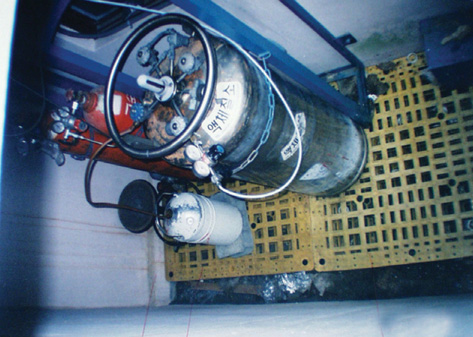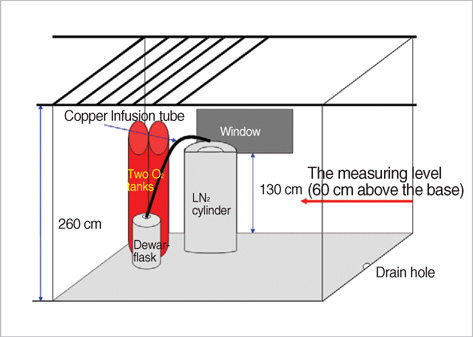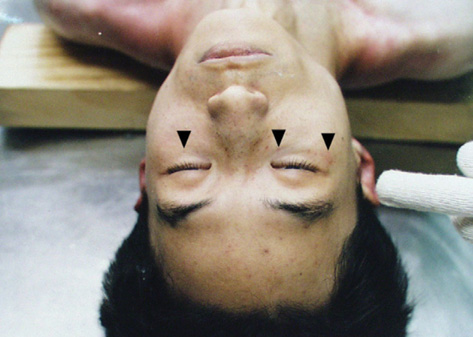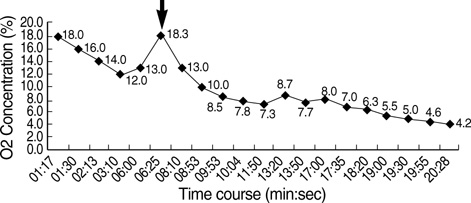J Korean Med Sci.
2008 Feb;23(1):163-165. 10.3346/jkms.2008.23.1.163.
Evaporated Liquid Nitrogen-Induced Asphyxia: A Case Report
- Affiliations
-
- 1Department of Pathology, Pohang Hospital, Dongguk University College of Medicine, Pohang, Korea. withdhk@naver.com
- 2Department of Obstetrics and Gynecology, Pohang Hospital, Dongguk University College of Medicine, Pohang, Korea.
- KMID: 1786868
- DOI: http://doi.org/10.3346/jkms.2008.23.1.163
Abstract
- A 27-yr-old postgraduate student was found lying at the floor of an unsealed underground dry area, where a valve-opened empty cylinder of liquid nitrogen (150 L) was connected to a cap-removed empty Dewar-flask (10 L) via a copper infusion tube. No injury was found externally or internally. There were petechiae in the bilateral conjunctivae and periorbital skin. The dry area, measuring 300X130X260 cm, had a communication to the basement of the research building by a window measuring 90X60 cm in size at 130 cm above the floor. The scene reconstruction and atmosphere gas analysis revealed that the O2 concentration at 60 cm above the base dropped to 12.0% in 3 min and 10 sec, 10.0% in 8 min and 53 sec, 6.0% in 18 min and 40 sec, and 4.2% in 20 min and 28 sec. The primary cause of death was asphyxia by evaporated liquid nitrogen..
Keyword
MeSH Terms
Figure
Cited by 1 articles
-
[secondary publication] Asphyxia due to Oxygen Deficiency by Evaporated Liquid Nitrogen
Jong Hyeok Park, Mia Kwon, Hyun Jee Kim, Byung-Tae Choi
Korean J Leg Med. 2015;39(3):88-91. doi: 10.7580/kjlm.2015.39.3.88.
Reference
-
1. Air Products. Safetygram-7, Liquid Nitrogen. 1998. 1–4.2. Safety Department, Imperial College London. Guidance Note 015, Liquid Nitrogen-Storage, Use and Transportation within College Premises. 2004. 1–15.3. Gill JR, Ely SF, Hua Z. Environmental gas displacement: Three accidental deaths in the workplace. Am J Forensic Med Pathol. 2002. 23:26–30.4. Kernbach-Wighton G, Kijewski H, Schwanke P, Saur P, Sprung R. Clinical and morphological aspects of death due to liquid nitrogen. Int J Legal Med. 1998. 111:191–195.
Article5. Tabata N, Funayama M, Ikeda T, Azumi J, Morita M. On an accident by liquid nitrogen-histological changes of skin in cold. Forensic Sci Int. 1995. 76:61–67.6. Wilkenfeld M. Rom WN, editor. Simple asphyxants. Environmental and occupational medicine. 1992. 2nd ed. USA: Lippincott Williams & Wilkins;535–538.7. Ely SF, Hirsch CS. Asphyxial deaths and petechiae: a review. J Forensic Sci. 2000. 45:1274–1277.
Article8. Di Maio VJM, Dana SE. Asphyxia. Handbook of Forensic Pathology. 1998. Texas, USA: Landes Bioscience;137.
- Full Text Links
- Actions
-
Cited
- CITED
-
- Close
- Share
- Similar articles
-
- [Secondary publication] Asphyxia due to Oxygen Deficiency by Evaporated Liquid Nitrogen
- Stomach Perforation Caused by Ingesting Liquid Nitrogen: A Case Report on the Effect of a Dangerous Snack
- Attempted Suicide by Nitrogen Gas Asphyxiation: A Case Report
- Larvicidal action of liquid nitrogen against metacercariae of Clonorchis sinensis
- Cryotherpy of warts with liquid nitrogen






